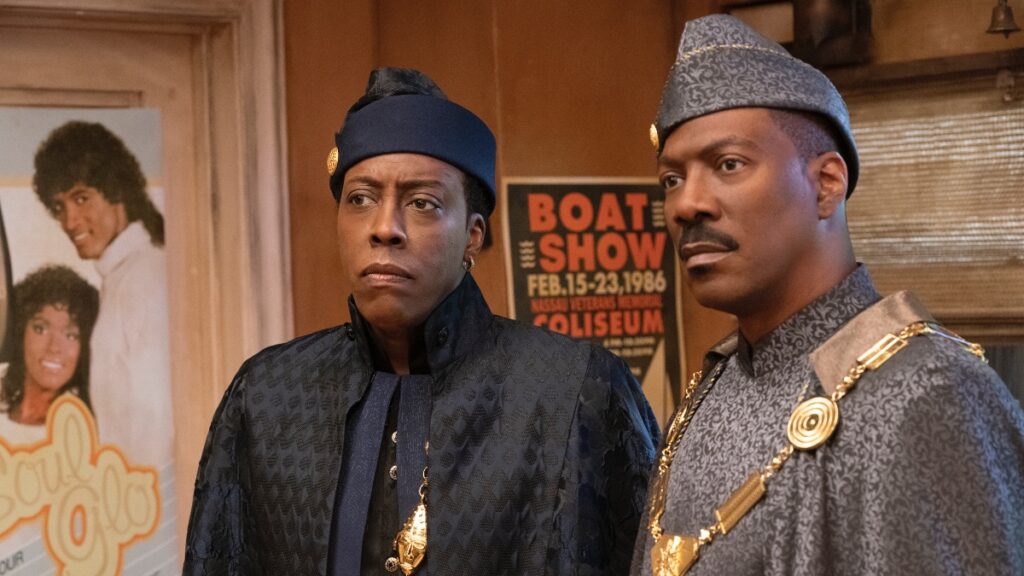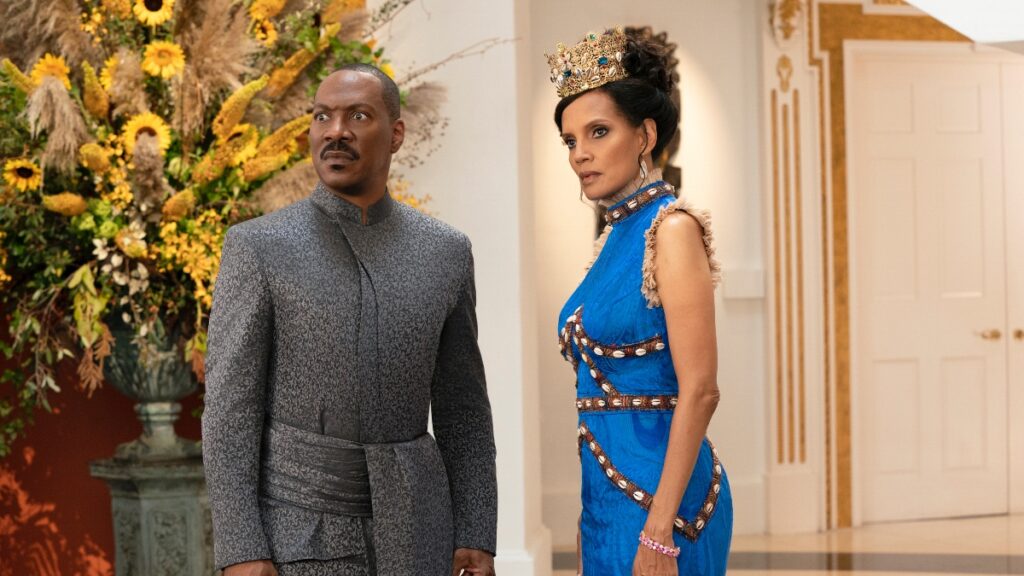
When Eddie Murphy and Arsenio Hall decided to revisit their characters from their popular 1989 comedy, Coming to America, they turned to Director Craig Brewer, who had done such a great job with Murphy’s previous film, Dolemite is My Name. Dolemite helped put Murphy back into the public consciousness, as well as into the awards race with the movie getting two Golden Globe nominations.
Back in 2005, Brewer’s second film, Hustle & Flow, is when people started paying attention as it won the Audience Award at the Sundance Film Festival that year then went on to Oscar night with Terrence Howard getting a Best Actor nomination and winning for Best Original Song. Brewer’s follow-up, Black Snake Moan, starring Samuel L. Jackson, kept Brewer intrinsically in the music world, as did his 2011 remake of Footloose, starring Miles Teller. After that, Brewer disappeared into the world of television for a while, most notably directing and acting as a consulting producer on the Fox show, Empire, again with Howard.
That brings us to Coming 2 America, which has Murphy and Hall returning as Akeem, now the king of the African nation of Zamunda, happily married to Lisa (Shari Headley) with three daughters, and his trusty aide Semmi. Without a son, Akeem needs to marry his eldest daughter off to create peace with a neighboring country. He then learns he may have an illegitimate son back in Queens, so he and Semmi return to America to meet his now adult son Lavelle (Jermaine Fowler) to teach him how to be a Zamundan prince. Unfortunately, that also means bringing his unruly family including his mother (Leslie Jones) and uncle (Tracy Jordan).
Below the Line had a great Zoom conversation with Brewer in which we spoke about working with the likes of Oscar winner Ruth E. Carter on costumes and Jody Williams as his DP, and how crucial they were to making the Zamunda scenes in particular look as good as they did in the first movie. But also, how they made Zamunda different from Black Panther’s Wakanda.

Below the Line: I think the last time we spoke was for Footloose, which must have been ten years ago.
Craig Brewer: It’s funny. I’ve been talking about Footloose a lot this time. Everyone is like, “What is this death wish you have with these classic ‘80s movies with people who loved the original so much, that you’re just tempting fate?”
BTL: I hadn’t watched the original Coming to America in about thirty years, so I put it on the night before watching your movie, and my first thought was “These people haven’t aged a day!” In fact, I could play the movies back-to-back, and it doesn’t seem like 30 years had passed, which was amazing.
Brewer: As you’ve seen, we had to do a sequence where we did some de-aging for Eddie and for Arsenio, for a flashback sequence, but I don’t know what they took off. [laughs]
BTL: I don’t think I noticed that.
Brewer: Which delights me to no end. You don’t understand how many sleepless nights, my FX Supervisor Jon Farhat and I had about the flashback sequence where we had to create all new stuff, but you were not the only one who was not aware of that. A lot of people thought I took footage from the original movie that was never used.
BTL: I think that’s what I assumed, because you do have other scenes from the first movie, so I just assumed you found some unused footage from John Landis’ film.
Brewer: No, no. Every day I hear this I feel so much better. [laughs]
BTL: You directed Eddie in Dolemite, so did you know at that time that he was developing this sequel the whole time? At what point did he say, “Hey…”?
Brewer: I knew that the sequel was in the works for a while with a script. I know that Kevin Misher, the producer, was in development on it for a while, well before Dolomite Is My Name, I believe. Then, I think there was this day where me and Keegan Michael Key were riffing on set as to like what I would do with an Axel Foley movie.
BTL: That’s next — you know that, right?
Brewer: I do now, yeah. I’ve heard that they’re developing that, but I don’t know if word got out, but I was just having fun with that. But we had a screening of Dolomite Is My Name, and Eddie came out of it and was like, “Are we doing Coming to America 2?” That’s kind of like when I became a part of it.
BTL: I’m amazed by how many people you got back from the original movie that I was not expecting. Obviously, Eddie and Arsenio, but also a few others, whom I don’t think I’ve seen in too many things since that first movie.
Brewer: I know, and some performances I think are so good. I think that Shari Headley is so good in the movie. I’m never one to say like, “Well, why aren’t they working more?” because everybody has their own reasons. Everybody has their own life, but Shari is so good in this movie, I would love to see her in a lot more movies and television. First of all, she looks just as beautiful as she did in the first movie, but she’s a good actress. Yes, she can play humor, but she’s good. She is a fine actress. There’s a lot of people. Arsenio Hall is someone in this movie that I think audiences forgot just how much they love to see Arsenio Hall in movies. It’s not just a combination of him and Eddie, that’s unquestionable, like that’s obvious. But there’s moments between Arsenio and Tracy Morgan in the movie that are hilarious, and he’s just incredibly talented.

BTL: One of the things that amazed me most was that you were able to recreate Zamunda and some of the character make-up looked exactly the same to me. Were you able to get some of the original people who worked behind the scenes for this movie or was it just new people trying to figure out what they did for the first movie?
Brewer: We really didn’t. I made a point like for Jeff Sage, our production designer, for Ruth E. Carter, our costume designer, and then Jody Williams, our DP. We would have conversations about what of the original do we want to keep? Not just narratively, but on a visual palette. Other than I believe my Script Supervisor, who worked on the first movie as the Script Supervisor, we didn’t have anybody really from the first movie work on this movie. We were all people that were very inspired by the first movie and wanted to build a world out of Zamunda, something that was in the first movie more of a bookend. The time you spend in Zamunda in the first movie is hilarious, especially on a royal level, this pomp that is unparalleled, even probably by the Windsor standards. You’ve got bathers. You’ve got people who brush your teeth, you got wipers. You’ve got elephants roaming free outside the window. Then what inspired me was these music numbers that would happen just by introducing one princess to Prince Akeem. For me, I was like, “Ah, that I’m going to have some fun with,” because I really put a lot of music in my movies and try to have these music sequences and the idea that I can tap into that Landis delightful lunacy, musical lunacy, was was a real opportunity for me.
BTL: I’m not sure I knew Ruth Carter did the costumes on this, but when I watched the original movie, I wondered if when she did the costumes for Black Panther, she took some inspiration from the Zamunda sequences? Wakanda is almost like a more serious, heightened version of Zamunda in some ways.
Brewer: It’s interesting, because there were times that we would have these conversations about what is Zamunda? And what is Wakanda? It’s kind of like the conversations J.J. Abrams has had with his people about, “Well, what’s Star Trek and what’s Star Wars?” Star Wars is kind of like a dirty universe that’s been around for hundreds of thousands of years where Star Trek is much more polished and much more of a naval warfare type of movie. We realized that Wakanda is still a place of warriors who are protecting the Wakandan way whereas Zamunda is a little bit more diplomacy. It’s got its roots in more of a colonial look from the first movie. Everyone’s in tuxedoes and suits and so forth. Ruth, what she really brought to it with her artistry was now building off of what close to more than three decades of cultural awareness that Western audiences now have of African design, African culture, African themes, and not thinking that Africa is just this one singular place. It’s a continent. There’s numerous different looks and designers that Ruth was inspired by, and I think she learned that through the lens of the work that she did with Black Panther. She just couldn’t phone it in. She knew that there is a cultural gravity to the decisions that she made with her design.
BTL: That’s amazing that you could get her for another movie after Dolemite, because I assume she’s in such demand these days. Was a lot of that Eddie being able to talk people to come back and do another movie?
Brewer: I think the great thing about what Ruth has discovered of working with Eddie, especially on these two movies, is she gets to really exercise her talent. I mean, some of the gowns that she constructed in this movie are breathtaking. I mean, every day I’d come in and Ruth would be there with the main talent showing me what they were wearing. There’s only so much that a drawing can show you and then you see it and you’re just like, “This is incredible.” So I love working with her, and I know that Eddie feels really safe and confident with all of her her decisions and her manner, and I would love to work with her every time I can.
BTL: I do want to talk more about your DP, because I wasn’t really familiar with Jody’s work. I’m always interested when I talk to directors about how they choose their heads of department, so how did you find Jody and want him to shoot this?
Brewer: Jody and I got to know each other when I produced about two seasons, I was in the room on Empire. I directed about 10 episodes of Empire, and a majority of those episodes Jody was the DP on. I tell people that I made four feature films before working on Empire, but I really think that I went to film school for the only time when I worked on Empire, because television, you’ve just got to make it work. You don’t have the time that you think you need, and you’ve got to make it work. But with Empire, Lee Daniels and Danny Strong but even more so, the Producer/Director Sanaa Hamri held this line of quality that it had to look cinematic, it had to look large. The costumes and the sets and the music numbers in Empire could not suffer from an eight-day shoot. So we had to learn how to make incredible music numbers and sequences without a lot of time and also to keep our cool. A lot of egos involved in that show and to some extent I feel like I was in training for Dolomite Is My Name and everything else on Empire. When it came time to do Coming 2 America, I was like, “Man, I think I need Jody. The only way that I’m going to be able to pull off the kind of production value on this movie with the time and the budget that was given to us, I need my buddy and my collaborator on Empire,” and Jody was perfect for it.
BTL: How did COVID affect this show? I imagine you finished all the shooting beforehand, but were you doing most of post during COVID?
Brewer: We did a lot of the post during COVID. I’m just gonna be blunt with you that it was a little bit of a nightmare at first, because there was about a dozen movies that were slated for 2020. And then COVID happened, and the industry kind of had to learn how to move forward like in real time with these movies. Every day, there was a new threshold. “Okay, we’re going to be coming out in the summer. Okay, now we’re going to be coming out in December.” But during that whole time, we’re still having to learn how to edit by way of Zoom and a program called Evercast. Then we had to test the movie, basically by Zoom, which is a nightmare. It worked for us, and it gave us all the information that we needed, but if you think that watching the backs of the heads of people in a screening of your movie with about 200 people packed into a theater, wait till you’re sitting there watching 200 to 300 people watching their laptop in their home. That’s a bit of humanity, you never really get a window into. So it’s a little bit nerve wracking when you’re watching them watch your movie that close.
But I have to say that, to some extent, the process still afforded us time to make the movie with Paramount and everybody in the post department at Paramount was understanding and gave us what we needed to do it under these circumstances. I’ll tell you the most incredible thing is that I live in Memphis, Tennessee, and I have a big office that is basically in a movie theater. I’ve got like a 7.1 movie theater with a screen and everything like that. It came time for me to mix the movie, and so that’s usually me spending three weeks on a mix stage, sometimes at Warner, sometimes at Disney, sometimes it’s Sony. I’ve been using a lot of the same people such as Greg Hedgepath, who worked as my Sound Supervisor, and Bobbi Banks who does ADR. We’ve worked [together] since Hustle and Flow — 15 years we’ve been making movies. And now, I’ve got to mix the movie, but they said, “You know what we’ll do – we’ll technically link your theater in Memphis to our soundstage, and you’ll be able to see and hear the work in real time” through this program, I believe it’s called Clearview.
Every day I was looking on a Zoom of my friends and collaborators, but I was also able to be a dad and see my daughter come home from school at the end of the day going like, “What were you doing, Dad?” “We are working on acclimating Wesley Snipes’ ADR into the cut. Come on in.” I gotta be honest with you — I don’t know if I’m going to go back. [laughs]
BTL: I’m hearing that a lot. People figure out how to do it, and then realize, “Hey, this isn’t so bad.” I’m not sure I would have known that a lot of movies I have seen had their post done remotely. I think I would love to see this movie with a big audience because I’m sure they’d go insane.
Brewer: Of course. That’s the sad thing about not being able to be in a theater is that comedies like this are designed for that kind of infectious laughter that you’re hearing. I live in Memphis, Tennessee — we talk to the screen – it’s not a one-way street when it comes to watching movies, but we even did like about two or three days of additional photography on the Paramount lot during COVID, having to learn how to shoot in COVID at a time when it was very new. I know that there’s probably going to be a book written about like this time in cinema’s advancement eventually that COVID basically ripped the band aid off some things that probably needed to change in our industry and some things that unfortunately have to change in our industry.
Coming 2 America will hit Amazon Prime Video on Friday, March 5. Look for interviews with the heads of the movie’s Make-Up departments soon.
All photos courtesy Amazon Prime Video except where noted. Photos by Quantrell D. Colbert.





